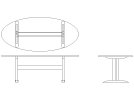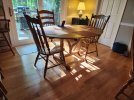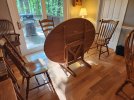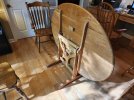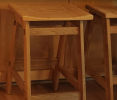You are using an out of date browser. It may not display this or other websites correctly.
You should upgrade or use an alternative browser.
You should upgrade or use an alternative browser.
Joinery choices: bolted stub tenon or through wedged tenon
- Thread starter wdw
- Start date
To me the key word in your post is "like". I like true woodworker's joinery; conversely I dislike joining wood together using screws, bolts, metal brackets, cumbersome braces, etc. If I was building this piece, I would use wedged through tenons on every single joint, including joining the legs to the top. Conventional mortise and tenon joints would be almost as strong. On the top-to-legs joints, round or square will work equally good. You'll have the option of using the same wood or different species (colors) for the top, under frame, and wedges. I would "like" a light colored top--maple, poplar, pine, ash, white oak--and a darker frame--walnut, cherry, mahogany--with wedges of the same wood as the top. Be proud of your craftsmanship; show it off.
Thanks for your comments. I appreciate your emphasis on craft display. The wood is selected and purchased, basic design you see, details in process. Wood first pass surface planed, nothing cut. Stability is most important. I have used wedged tenon on trestle table feet before and they have held up, I have used bolted stub tenon on beds and trestle table stretchers. I can tighten a bolt with a nut, a loosened through tenon is another matter. The top for this is estimated a bit over 300 lbs at 1", may make it a bit less than 1" to reduce weight. Still thinking about it . . .
Neither one of us is thinking this all the way through. You've got approximately 36" of table top between the tops of the legs. How are you going to allow for seasonal wood movement? Any kind of solid attachment at the tops of the legs, conventional joinery or mechanical, is going to form a solid connection. The ~36" of wood between the legs is going to expand in summer and bust the framework right apart.
You certainly don't want mechanical screw joints in the under trestle that has to be tightened and loosened twice a year with the seasons. Sure enough, some year someone is going to forget to adjust it and KABLAM!.
There are all kinds of ways to attach a top to an under frame. For something this large and heavy I would "like" Z clips, lots of them, sliding in dado grooves. I would also add a trestle brace glued and screwed to the underside of the top to provide some lengthwise support for the ~ 5' span between the leg sets.
There will still be enough mortise and tenon joinery in the under frame to subtly show off your craftsmanship. Wedged through tenons will show off kind of like the main joints in a Maloof chair design.
You certainly don't want mechanical screw joints in the under trestle that has to be tightened and loosened twice a year with the seasons. Sure enough, some year someone is going to forget to adjust it and KABLAM!.
There are all kinds of ways to attach a top to an under frame. For something this large and heavy I would "like" Z clips, lots of them, sliding in dado grooves. I would also add a trestle brace glued and screwed to the underside of the top to provide some lengthwise support for the ~ 5' span between the leg sets.
There will still be enough mortise and tenon joinery in the under frame to subtly show off your craftsmanship. Wedged through tenons will show off kind of like the main joints in a Maloof chair design.
Z-tabs for the table connection have been my plan all along - been using them for years on table tops. Thinking more now to wedged tenons on both ends of the legs. I have wedged tenons in some stools and a Vineyard table (tilting top and harp mechanism). The Vineyard table is elliptical shape, but smaller - 42 x 60. Stretchers . . .
Attachments
The top is 40 x 90.
The top for this is estimated a bit over 300 lbs at 1", may make it a bit less than 1" to reduce weight.
300 pounds for the top seems a bit high if it's made out of hickory as you mentioned in another thread. By my calculation the volume of the top is only about 1.64 cubic feet and from what I can find online, the density of hickory is between 37 and 58 pounds per cubic foot. So a little over 95 pounds with the densest hickory. Maybe I've missed something in your design?
I started by getting area for ellipse and weight for hickory, estimated range got me to about 300. I then asked CHATGPT, without specifying kiln dried, it came back with range beginning about 325. I just asked CHATGPT again for kiln dried hickory and here is what it returned (all this AI is "experimental"!):
+++++++++++++++++++++++++++++++++++++++++++++++++++++++++++++++++++
If you’re asking about the weight of a table top that is an elliptical shape with a semi-major axis of 90 inches, a semi-minor axis of 40 inches, and a thickness of 1 inch made of kiln-dried hickory, then you can calculate the weight using the density of kiln-dried hickory and the volume of the table top. Kiln-dried hickory typically weighs between 35 and 40 pounds per cubic foot1. The volume of the table top can be calculated by multiplying the area of the ellipse by its thickness. The area of an ellipse can be calculated using the formula A = π * a * b, where a and b are the lengths of the semi-major and semi-minor axes, respectively. In your case, if the semi-major axis is 90 inches and the semi-minor axis is 40 inches, then the area of the ellipse would be A = π * 90 * 40 = 3600π square inches. Since there are 12 inches in a foot, we can convert this to square feet by dividing by 144: 3600π/144 = 25π square feet. Multiplying this by the thickness of 1 inch (or 1/12 foot) gives us a volume of 25π/12 = approximately 6.55 cubic feet. Multiplying this by the density of kiln-dried hickory (35-40 pounds per cubic foot) gives us a weight range of approximately 229.25 - 262 pounds.
+++++++++++++++++++++++++++++++++++++++++++++++++++++++++++++++++++
If you’re asking about the weight of a table top that is an elliptical shape with a semi-major axis of 90 inches, a semi-minor axis of 40 inches, and a thickness of 1 inch made of kiln-dried hickory, then you can calculate the weight using the density of kiln-dried hickory and the volume of the table top. Kiln-dried hickory typically weighs between 35 and 40 pounds per cubic foot1. The volume of the table top can be calculated by multiplying the area of the ellipse by its thickness. The area of an ellipse can be calculated using the formula A = π * a * b, where a and b are the lengths of the semi-major and semi-minor axes, respectively. In your case, if the semi-major axis is 90 inches and the semi-minor axis is 40 inches, then the area of the ellipse would be A = π * 90 * 40 = 3600π square inches. Since there are 12 inches in a foot, we can convert this to square feet by dividing by 144: 3600π/144 = 25π square feet. Multiplying this by the thickness of 1 inch (or 1/12 foot) gives us a volume of 25π/12 = approximately 6.55 cubic feet. Multiplying this by the density of kiln-dried hickory (35-40 pounds per cubic foot) gives us a weight range of approximately 229.25 - 262 pounds.
Interesting. Simplify it to a rectangular top.
40 x 90 x 1 = 3600 cubic inches.
1 cu. ft = 1728 cu. in. (12^3)
3600 / 1728 = 2.0833 cubic feet.
Assuming 40 lbs/cu. ft ---- 40 x 2.0833 = 83.332 lbs.
And basically you'll lop of the corners to make it an ellipse so the weight will be reduced. I get 1.64 cubic feet for the elliptical top. At 40 lbs thats 65.6 pounds.
Here I've let SketchUp calculate the volume automatically The cube and the rectangular solid to show that the calculation is correct.

40 x 90 x 1 = 3600 cubic inches.
1 cu. ft = 1728 cu. in. (12^3)
3600 / 1728 = 2.0833 cubic feet.
Assuming 40 lbs/cu. ft ---- 40 x 2.0833 = 83.332 lbs.
And basically you'll lop of the corners to make it an ellipse so the weight will be reduced. I get 1.64 cubic feet for the elliptical top. At 40 lbs thats 65.6 pounds.
Here I've let SketchUp calculate the volume automatically The cube and the rectangular solid to show that the calculation is correct.
It does kind of make me wonder what else it might get wrong.
We need to learn how to communicate with these systems and consider results with critical reasoning, they will improve. I just asked OpenAI GP4 the same question and received an even worse answer. Not trained yet in woodworking - I tried to ask it for a 3d sketch, but that app wants money! I think there are some free ones though . . .
ChatGTP is an interesting creation. What it hasn’t learned it is programmed to guess. Sort of a human character in some ways. It doesn’t notify you of what is truth and what is guess. You have to dig into the ‘coding’ to identify truth and guess.
Since I don’t use and have only attended training am I sparking truth or guess?
Since I don’t use and have only attended training am I sparking truth or guess?
Maybe a hallucination?ChatGTP is an interesting creation. What it hasn’t learned it is programmed to guess. Sort of a human character in some ways. It doesn’t notify you of what is truth and what is guess. You have to dig into the ‘coding’ to identify truth and guess.
Since I don’t use and have only attended training am I sparking truth or guess?
Actually I think you used major axis and minor axis dimensions when the formula called for semi-major and semi minor. Same problem occurs if you use diameter instead of radius in calculating the area of a circle.
using pi x 20x 45 gives an area of 2827 sq in or 19.63 sq ft
volume at 1” thick would be 2827 cu in or 1.636 cu ft
weight would be 1.636 x 40 = 65.44 lb
difference from the 83 lb @Dave Richards calculated is the difference between the elipse and the rectangle that contains it.
using pi x 20x 45 gives an area of 2827 sq in or 19.63 sq ft
volume at 1” thick would be 2827 cu in or 1.636 cu ft
weight would be 1.636 x 40 = 65.44 lb
difference from the 83 lb @Dave Richards calculated is the difference between the elipse and the rectangle that contains it.
Good catch.difference from the 83 lb @Dave Richards calculated is the difference between the elipse and the rectangle that contains it.
FWIW I also came up with 65+ lbs for the elliptical top and included that in my post.
I should read the notes instead of looking at the pictures!Good catch.
FWIW I also came up with 65+ lbs for the elliptical top and included that in my post.
Agree with smallboat - it's just pi x a x b (unlike the circumference which has no closed form formula).
Back to the original question --- if this were my project, I'd add top stretchers lengthwise. Screw one of the stretchers to the top and use "z" clips on the other. It's how I do all table tops - it provides a degree of solidness via the screws, but allows the other edge to float.
Back to the original question --- if this were my project, I'd add top stretchers lengthwise. Screw one of the stretchers to the top and use "z" clips on the other. It's how I do all table tops - it provides a degree of solidness via the screws, but allows the other edge to float.
Would like to know more what you mean. Shift stretchers up to the table top or do you mean additional stretchers? This is my first twin post trestle so interested in viewpoints/ideas.Agree with smallboat - it's just pi x a x b (unlike the circumference which has no closed form formula).
Back to the original question --- if this were my project, I'd add top stretchers lengthwise. Screw one of the stretchers to the top and use "z" clips on the other. It's how I do all table tops - it provides a degree of solidness via the screws, but allows the other edge to float.
Thanks,
Add two lengthwise stretchers (Maybe that would be called an apron?) that span the depthwise stretchers. Leave the bottom as you have drawn.
Since the upper stretchers' grain will run the same as the top, you can screw one of them to the top. The other needs to float since the depthwise stretchers are cross grain with the top. Cut a slot in both depthwise and the one lengthwise to accommodate the z clips on those three sides of the frame.
Since the upper stretchers' grain will run the same as the top, you can screw one of them to the top. The other needs to float since the depthwise stretchers are cross grain with the top. Cut a slot in both depthwise and the one lengthwise to accommodate the z clips on those three sides of the frame.
Hmmm. And now we are arguing with AI models.
LATEST FOR SALE LISTINGS
-
-
-
-
SOLD -- $75: Gast moa v113 Vacuum Pump Veneer, 60" bag and board
- Started by peterdnight
- Replies: 1
-
GONE: Gladiator 5 cleats, 10 hangers, Paper Towel and Shelf
- Started by peterdnight
- Replies: 3

